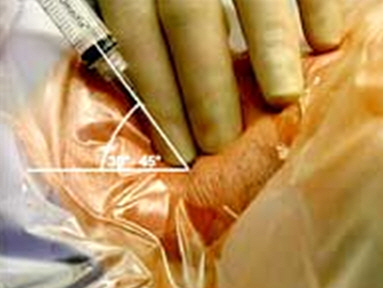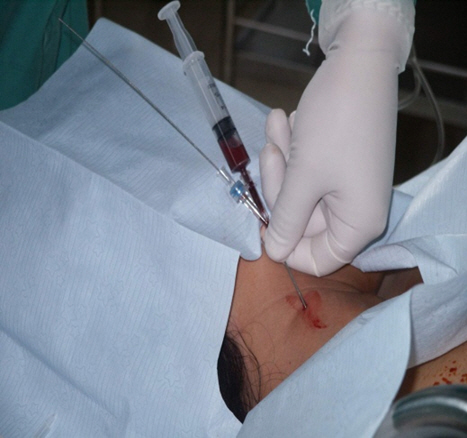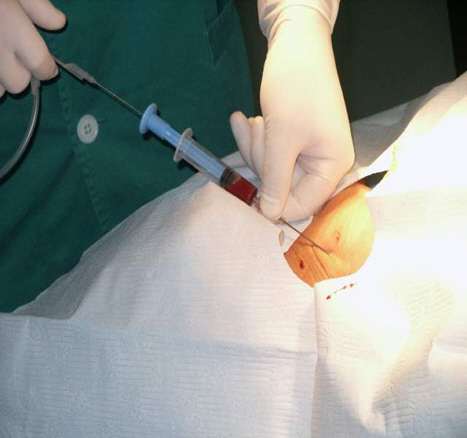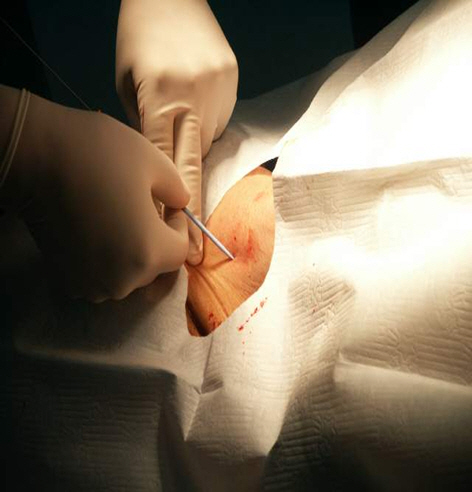Placement guideline
1) Place the patient in a trendelenberg position (15 to 30 degrees head down) to reduce the chance of an air embolism, turn the patient’s head to the side contralateral to the site chosen.
2) mark puncture site
3) Anesthetize the spot by using needle, the angle between needle and skin shall be 30 to 45 degrees
4) when a flush of blood returns by advancing the needle, insert venous needle.
Remarks: pay attention to the direction of needle and color of blood returns during advancing seeker needle, meanwhile, pay attention to the direction of needle and depth of puncturing needle, the bevel of needle shall be faceup.

5) one hand hold the needle,another hand hold the syringe ,keep the pressure negative during the slow insertion. When you feel the needle placed into the vein, the blood will return smoothly.
6) Guidewire will be inserted through Y shaped syringe or hollow syringe.
Remarks: during the insertion of guidewire,please judge the resistance , don’t withdraw the guidewire by force, withdraw the guidewire together with syringe if necessary.


7) withdraw syringe, and insert dilator by 1-2 cm under the skin for enlarge the track.
Remarks: During insertion of dilator, attention shall be paid to the direction and the force of dilator, especially the force transferring between dilator and guidewire, the driving force shall be increased gradually

8)Withdraw the dilator, implant the catheter from the end of guidewire, and saline shall be injected into to the catheter immediately.
9)Ensure the whole catheter implanted completely and then fixed the catheter at the final position.
10)Connect with other tubes and devices
Remarks: The force for inserting the catheter is related to enlarging of the track, if the resistance is big, the length of each insertion shall be shorter, and attention shall be paid to avoid kink of guidewire.
Nursing care after placement of the hemodialysis catheter
- check the fixation of catheter if reliable, breeding or not and make sure the catheter is through and the blood flow rate is satisfactory.
- disinfect the puncture site and catheter after each dialysis treatment, flush the catheter with 10-20ml saline, then inject 2-3ml sodium heparin, then, use new heparin cap or needless connector to lock the catheter (in case of serious cruor, increase the use of heparin, even use the original concentration of heparin). fix the catheter with dressing. at the beginning of new treatment, nurse shall withdraw the heparin and saline before connection with blood line.
- the original concentration of heparin can be maintained for 24 hours, while in use of saline and heparin, the catheter shall be flushed each 8 hours.
- The puncture site shall be kept dry and clean, once the dressing is wet or contaminated, it shall be change.
- infection: this is common issue, if the infection not caused by others factors, the catheter shall be removed and do the bacterial culture by using the tip.
- bleeding: bleeding occur at the site, or haematoma occurs, bleeding will become worse after usage of heparin, local compression shall be adopted to stop bleeding, and adjust the usage of heparin, if necessary, remove the catheter.
- thrombus: indwelling time is too long, patient is in the situation of serious cruor, lost of heparin or the catheter is twisted by compression, all these factors may cause thrombus, the catheter shall be removed, or use Urokinase to eliminate thrombus.
- drop off catheter: normally it caused by unfirm fixation or over indwelling time, in this case, detect the integrality of catheter under X -ray, then remove the catheter.
- Leakage of hollow syringe
- there is difference between front end of hollow syringe and the taper of hub of needle
- the connection between front end of hollow syringe and the hub of needle is not firmed
- there is difference between handspike’s rubber and Cylinder
- Leakage of catheter
- Defective material (outsourcing)
- Technics of each part’s connection
- physical damages to catheter during the operation
- infuse hyperosmotic and corrosive medicine
- Insufficient flow rate:
- the inside surface of catheter may not smooth or with flash.
- lumen side become narrow because of over indwelling time and lost of heparin.
- the puncture site not match the length of catheter
- the side holes were touched by venous valve (femoral)
If you would like to know more about our hemodialysis catheter product, you can visit our dedicated page:
Link to our hemodialysis catheter product
